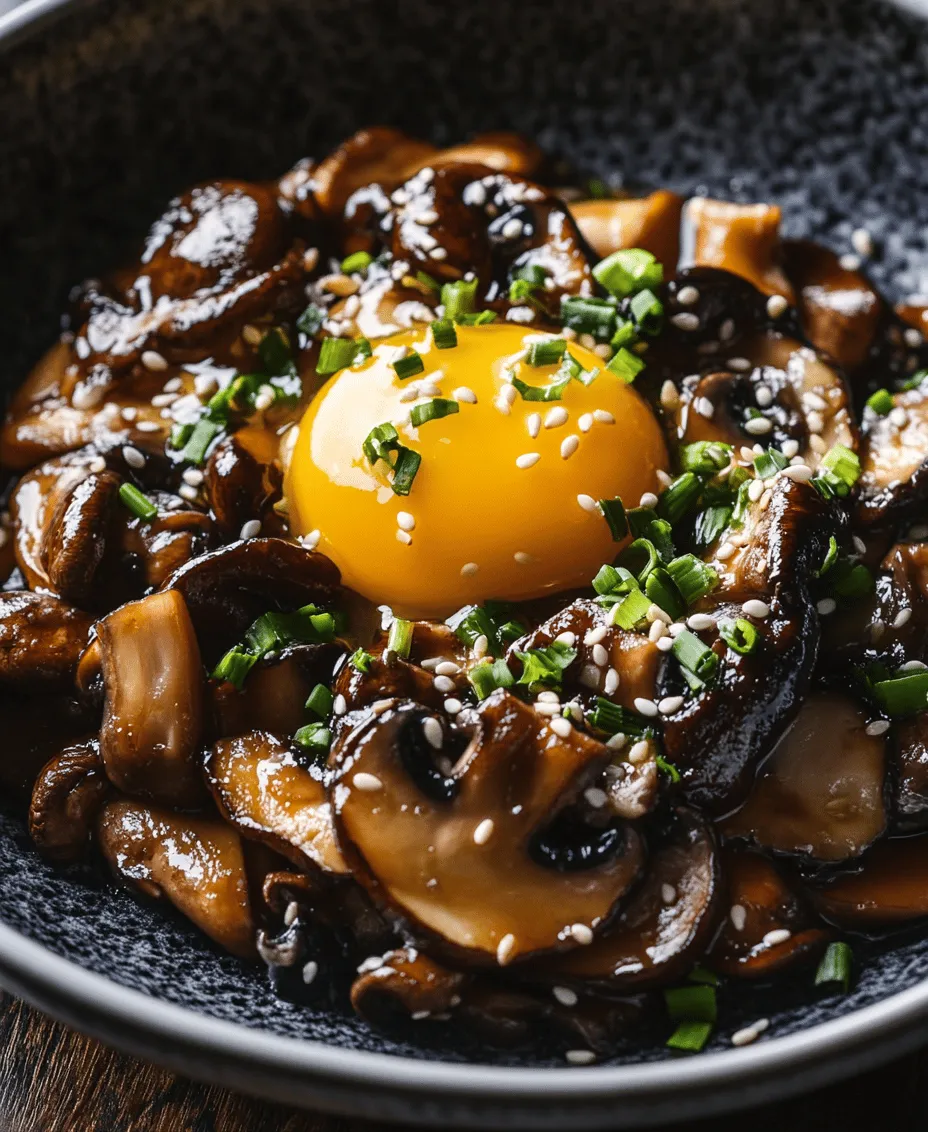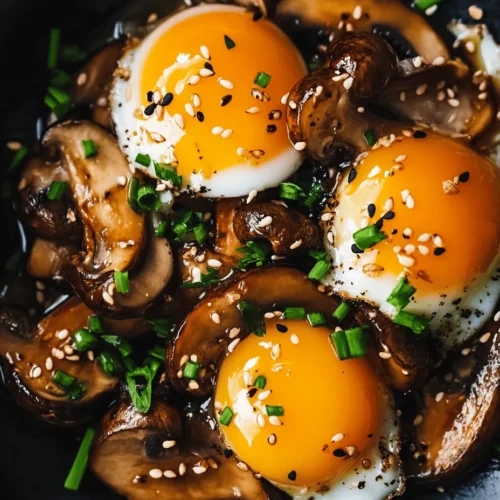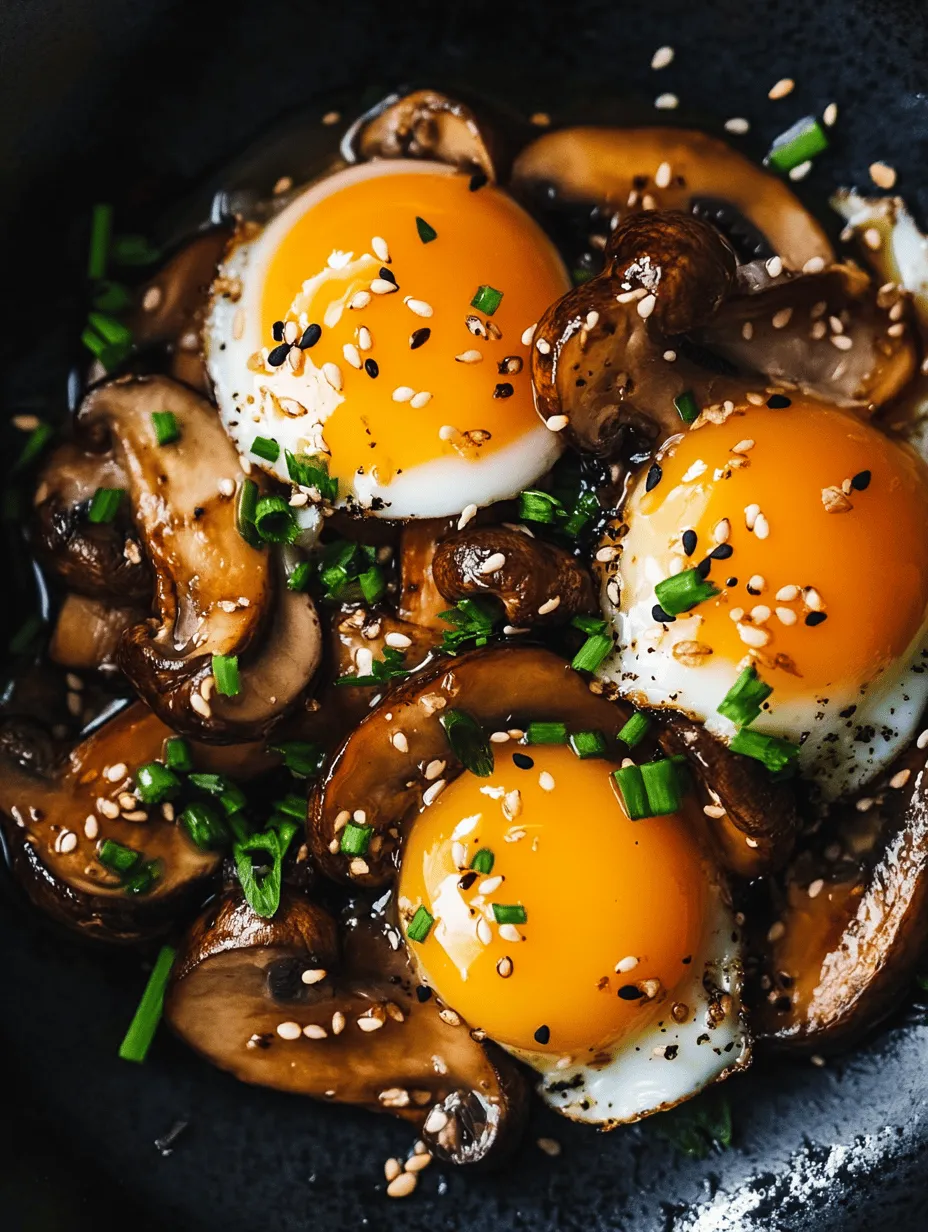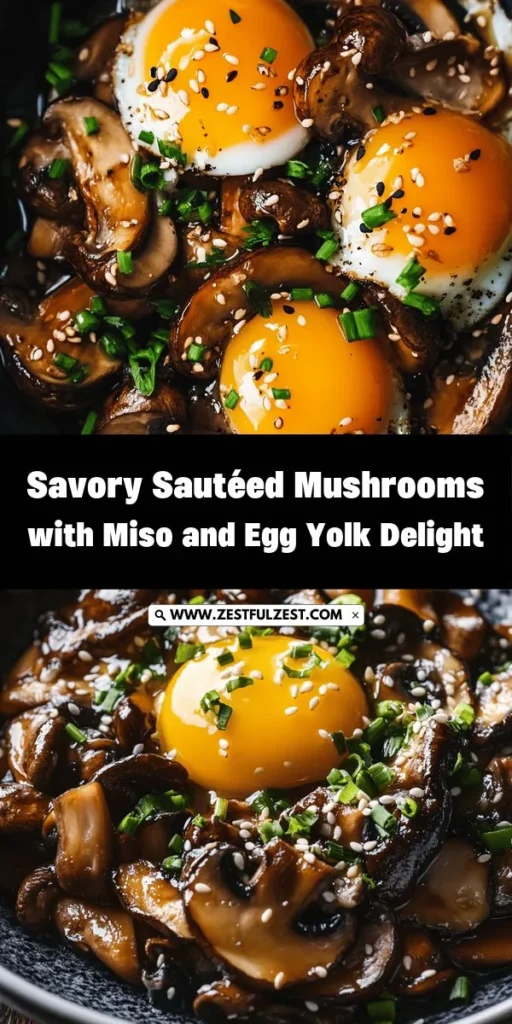Introduction
In the world of culinary delights, few flavors are as captivating as umami—the savory taste that lingers on the palate and elevates dishes to new heights. If you’re seeking a recipe that embodies this delectable flavor profile, look no further than our “Sautéed Umami Bliss: Pan-Fried Mushrooms with Miso and Egg Yolk.” This dish combines the rich earthiness of mushrooms with the depth of miso, creating a memorable dining experience that’s both satisfying and indulgent.
At the heart of this dish are the key ingredients: fresh mushrooms, miso paste, and egg yolks. The mushrooms serve not only as the star of the show but also bring along a multitude of health benefits. Varieties such as shiitake, oyster, and button mushrooms are not just delicious; they are packed with essential nutrients, antioxidants, and immune-boosting properties. Miso, a fermented soybean paste, adds a complex umami flavor along with probiotics that promote gut health. Together, these ingredients create a dish that is both flavorful and nourishing.
The purpose of this article is to provide you with a comprehensive guide to making this savory dish. We will break down each ingredient, discuss its importance, and walk you through the steps needed to create the perfect pan-fried mushrooms with miso and egg yolk. Whether you are a seasoned cook or a culinary novice, you will find value in this detailed exploration of flavors and techniques.
The Ingredients Breakdown
Fresh Mushrooms
When it comes to the star ingredient of this dish, fresh mushrooms are essential. There are several types of mushrooms you can use, each contributing its unique flavor and texture to the dish:
– Shiitake Mushrooms: Known for their rich, meaty texture and slightly smoky flavor, shiitake mushrooms are a fantastic choice for this recipe. They hold their shape well during cooking and absorb flavors beautifully, making them perfect for sautéing.
– Oyster Mushrooms: With their delicate, velvety texture and mild, anise-like flavor, oyster mushrooms add a unique twist to the dish. They cook quickly and provide a subtle sweetness that complements the umami profile.
– Button Mushrooms: The classic choice, button mushrooms are widely available and have a mild flavor that allows the other ingredients to shine. They are versatile and can be used in various dishes, making them a staple in many kitchens.
Choosing a combination of these mushrooms can create a delightful medley of textures and flavors, enhancing the overall experience of the dish. Regardless of the type you choose, make sure they are fresh and firm, as this ensures the best taste and texture.
Olive Oil and Butter
The fats you use in cooking play a crucial role in flavor enhancement and mouthfeel. In this recipe, a combination of olive oil and butter is recommended. Olive oil is an excellent source of healthy fats and adds a fruity note to the dish, while butter introduces a rich creaminess that elevates the overall taste.
When cooking mushrooms, the fat helps to create a golden-brown crust, enhancing their natural flavors. The combination of these two fats not only provides a delicious flavor but also ensures that the mushrooms sauté perfectly. For best results, opt for high-quality extra virgin olive oil and unsalted butter.
Miso Paste
Miso is the secret weapon behind the umami flavor of this dish. This fermented soybean paste is a staple in Japanese cuisine and comes in various types, including white, yellow, and red miso. Each type has its distinct flavor profile:
– White Miso: Mild and slightly sweet, white miso is perfect for those new to miso. It blends easily with other ingredients and adds a gentle umami flavor.
– Yellow Miso: A step up in intensity, yellow miso has a more pronounced savory taste and is versatile in many dishes.
– Red Miso: Bold and robust, red miso offers a deep umami flavor that complements hearty ingredients. It works superbly in this mushroom dish, adding depth and complexity.
In addition to its flavor, miso is rich in probiotics, vitamins, and minerals, making it a nutritious addition to any meal. When using miso in this recipe, be sure to use it sparingly, as it can be quite salty.
Soy Sauce and Sesame Oil
To further enhance the savory notes in this dish, soy sauce and sesame oil are included. Soy sauce adds a salty, umami-rich element, while sesame oil contributes a nutty aroma that elevates the overall flavor profile.
Using these ingredients in moderation allows you to balance the flavors without overpowering the dish. Opt for low-sodium soy sauce if you’re watching your salt intake, and choose toasted sesame oil for a richer taste.
Aromatics
The role of aromatics—such as garlic, shallots, and ginger—in building flavor cannot be understated. These ingredients serve as the foundation of the dish, providing depth and complexity that elevate the mushrooms to new heights.
– Garlic: Fresh garlic adds a pungent, savory flavor that pairs beautifully with mushrooms. Sautéing garlic until it’s fragrant ensures that its flavors are released into the dish.
– Shallots: Milder than onions, shallots bring a subtle sweetness and a touch of elegance to the dish. They caramelize beautifully, adding a nuanced flavor that complements the umami profile.
– Ginger: Fresh ginger adds a zesty kick and a hint of warmth. Its aromatic qualities enhance the overall flavor, creating a well-rounded dish.
When preparing these aromatics, be mindful of their cooking times. Garlic can burn quickly, so it’s essential to sauté it at the right moment to achieve optimal flavor without bitterness.
Egg Yolks
Egg yolks play a crucial role in this recipe, providing a luxurious, creamy texture that binds the dish together. Using high-quality yolks is essential, as they contribute not only to flavor but also to the overall richness of the dish.
When selecting eggs, look for organic, free-range options, which are often richer in flavor and color. The yolks should be vibrant and firm, indicating freshness. Incorporating the yolks at the end of the cooking process allows them to gently cook and create a silky sauce that coats the sautéed mushrooms.
Garnishes
Elevating the dish further are the garnishes: fresh chives, green onions, and sesame seeds. These elements not only add visual appeal but also contribute additional layers of flavor and texture.
– Chives: Their mild onion flavor adds a fresh note that balances the richness of the dish.
– Green Onions: Sliced green onions provide a crunchy texture and a burst of color, enhancing the dish’s visual appeal.
– Sesame Seeds: Toasted sesame seeds add a nutty crunch and a hint of earthiness, rounding out the flavors beautifully.
Incorporating these garnishes just before serving ensures they retain their freshness and vibrancy, making for an attractive and appetizing presentation.
Preparation Steps Detailed
Preparing Mushrooms
Before diving into the cooking process, it’s essential to prepare the mushrooms properly. Start by cleaning them with a damp cloth or a soft brush to remove any dirt or debris. Avoid soaking them in water, as mushrooms are like sponges and can absorb excess moisture, leading to a soggy texture.
Once clean, slice the mushrooms uniformly to ensure even cooking. For shiitake mushrooms, remove the tough stems and slice the caps into thin strips. Oyster mushrooms can be left whole or sliced, depending on their size, while button mushrooms should be halved or quartered, depending on your preference. Aim for pieces that are about the same size, as this will help them cook evenly and develop a nice caramelization.
Heating the Pan
The next step is heating your pan, which is crucial for achieving that perfect sautéed texture. Choose a heavy-bottomed skillet or sauté pan, as these retain heat well and promote even cooking. Begin heating the pan over medium-high heat and add a combination of olive oil and butter.
As the fats heat up, keep an eye on the temperature. You want the oil and butter to shimmer, indicating that they are hot enough for cooking. If the butter starts to brown, it’s a sign that the pan is too hot, and you should reduce the heat slightly. The goal is to create a hot surface that will sear the mushrooms and develop a golden crust while preventing the aromatics from burning.
Sautéing Aromatics
Once your pan is heated and the fats are shimmering, it’s time to add the aromatics. Start with the shallots and garlic, sautéing them for about 30 seconds until they become fragrant and translucent. Be careful not to let them burn, as burnt garlic can impart a bitter flavor to the dish.
Next, add the ginger and continue to sauté for an additional 30 seconds, allowing it to release its aromatic qualities. Once the aromatics are softened and fragrant, it’s time to add the sliced mushrooms to the pan.
As you add the mushrooms, ensure they are spread evenly across the surface of the pan. This allows each piece to make contact with the heat, promoting even cooking and browning. Resist the urge to stir too frequently; let the mushrooms cook undisturbed for a couple of minutes to develop a nice sear before tossing them.
As the mushrooms release their moisture, they will begin to caramelize, enhancing their natural flavors. Continue to sauté them until they are golden brown and tender, which typically takes about 5-7 minutes.
With these initial steps, you are well on your way to creating a mouthwatering dish that showcases the beauty of umami flavors. Stay tuned for the next part of this article, where we will delve deeper into the cooking process, incorporating miso and egg yolks, and finishing with the perfect garnishes for an unforgettable culinary experience.

Cooking the Mushrooms
To create the perfect sautéed mushrooms that are golden brown and full of flavor, the technique is key. Begin with fresh, high-quality mushrooms, as their natural sweetness and umami will enhance the dish. Clean them gently using a damp cloth rather than rinsing them under water, as mushrooms are like sponges and will absorb excess moisture, which can hinder browning.
Techniques for Achieving Golden Brown Mushrooms
1. Slice Uniformly: Cut the mushrooms into even slices, about 1/4 inch thick. This will ensure they cook evenly, allowing for that desirable golden crust.
2. Heat the Pan: Use a heavy-bottomed skillet or a cast-iron pan to provide even heat distribution. Preheat the pan over medium-high heat until it’s hot enough that a drop of water sizzles upon contact.
3. Oil It Right: Add a high smoke point oil, such as vegetable oil or canola oil, to the pan. Swirl the oil to coat the bottom evenly. You can also add a little butter for richness, but make sure to balance the timing to prevent it from burning.
4. Don’t Crowd the Pan: Add the mushrooms in a single layer without overcrowding. If necessary, cook them in batches. Overcrowding releases moisture, which steams the mushrooms instead of browning them.
5. Let them Sauté: Allow the mushrooms to cook undisturbed for a few minutes. This will help them develop a golden crust. After a few minutes, give them a stir to ensure even cooking.
6. Release Moisture: Continue to sauté until the mushrooms have released their moisture and are a deep golden brown, about 5 to 7 minutes. You’ll know they’re done when they have shrunk in size and are tender.
Incorporating Flavors
Once your mushrooms are perfectly sautéed, it’s time to elevate their flavor profile with the addition of miso, soy sauce, sesame oil, and ginger. This combination will create a rich, umami-packed dish that tantalizes the taste buds.
The Process of Adding Miso and Other Flavor Agents
1. Prepare the Sauce: In a small bowl, mix together a tablespoon of miso paste with a tablespoon of hot water to create a smooth paste. This helps the miso dissolve more easily into the dish.
2. Add the Flavor Enhancers: Once the mushrooms are golden brown, reduce the heat to medium. Pour in the miso mixture, followed by a splash of soy sauce and a drizzle of sesame oil. Stir swiftly to ensure even distribution.
3. Incorporate Fresh Ginger: Finely grate a teaspoon of fresh ginger and add it to the pan. The warmth from the mushrooms will help release the aromatic oils in the ginger, further enhancing the dish’s flavor.
4. Toss and Taste: Toss everything together gently, allowing the mushrooms to absorb the flavors. Taste and adjust seasoning if necessary—add a pinch of salt or a dash of soy sauce to your preference.
Preparing the Egg Yolks
The egg yolks play a crucial role in adding richness and a velvety texture to the dish. Separating yolks can be tricky, but with a little practice, it becomes second nature.
Techniques for Separating Yolks
1. Chill Your Eggs: If possible, use cold eggs as they are easier to separate. Room temperature eggs can be more delicate and break easier.
2. Crack with Precision: Gently tap the egg on the counter to crack it. Do this over a bowl to catch the whites.
3. Separate the Yolk: Hold the egg over a separate bowl, and gently use your fingers to separate the yolk from the white. Alternatively, you can use an egg separator for more precision.
4. Incorporate into the Dish: Once all yolks are separated, gently slide them onto the cooked mushrooms. The residual heat will slightly cook the yolks, allowing them to meld beautifully with the dish without scrambling.
Serving Suggestions
Presentation Tips
Plating is an art that elevates the dining experience. For this dish, consider the following:
– Use a Wide Plate: This allows for the mushrooms to spread out, showcasing their golden hue.
– Garnish: Sprinkle finely chopped green onions or sesame seeds over the dish for a pop of color and texture.
– Add a Drizzle: A light drizzle of sesame oil or a few drops of chili oil can add a finishing touch that enhances both flavor and presentation.
Pairing Ideas
This sautéed umami dish is versatile and can be paired with various sides:
– Rice: Serve it over a bed of steamed jasmine or brown rice to soak up the flavorful sauce.
– Noodles: Toss in some udon or soba noodles for a heartier meal, allowing the noodles to absorb the delicious umami flavors.
– Salads: A crisp green salad with a light vinaigrette balances the richness of the mushrooms.
Versatility of the Dish
This recipe can flexibly serve as an appetizer, side, or main dish. As an appetizer, serve smaller portions with toothpicks or as part of a tapas-style meal. As a side, it complements grilled meats or fish beautifully. When served as a main dish, bulk it up with rice or noodles to make it satisfying and complete.
Nutritional Analysis
Breakdown of Nutritional Benefits
The ingredients in this dish are not only delicious but also packed with nutrients:
– Mushrooms: Low in calories and high in antioxidants, mushrooms are a great source of B vitamins, selenium, and vitamin D (especially when exposed to sunlight).
– Miso: This fermented soybean paste is rich in probiotics, promoting gut health, and is a good source of protein.
– Egg Yolks: Rich in healthy fats and essential vitamins (like A, D, and B12), egg yolks also contain choline, which is beneficial for brain health.
The Role of Umami
Umami is often referred to as the fifth taste, and it’s a powerful flavor that enhances the overall satisfaction of a meal. Foods high in umami, like mushrooms and miso, can help increase satiety, making you feel fuller with smaller portions.
Vegetarian-Friendly Aspects
This dish is entirely vegetarian-friendly and can easily fit into a balanced diet. The combination of mushrooms and miso provides a hearty, nutrient-dense meal that is satisfying without relying on meat.
Culinary Techniques Explored
The Importance of Sautéing
Sautéing is a fundamental cooking method that uses a small amount of fat over relatively high heat. It promotes the Maillard reaction—responsible for the browning of food—which develops complex flavors in the dish. Proper sautéing ensures that the natural flavors of the ingredients shine through while also creating a delightful texture.
Proper Incorporation of Miso
Miso should be treated with care to retain its beneficial properties. When adding miso to a hot pan, it’s crucial to dissolve it in a small amount of liquid to prevent clumping. Avoid boiling miso, as high heat can destroy the probiotics and delicate flavors.
Emulsification of Egg Yolk
When egg yolks are added to warm ingredients, they create a natural emulsification, resulting in a creamy texture. This technique is commonly used in pasta dishes and sauces, enhancing the mouthfeel and richness without the need for cream or butter.
Conclusion
Sautéed Umami Bliss: Pan-Fried Mushrooms with Miso and Egg Yolk is a dish that celebrates the deep, rich flavors of umami while being accessible and easy to prepare. Its golden-brown mushrooms, infused with miso and complemented by the luscious egg yolks, create a dish that appeals to a wide range of palates, from the culinary novice to the seasoned chef.
This recipe is an invitation to experiment with different varieties of mushrooms and to explore variations by incorporating other ingredients or spices. The joy of cooking comes not just from the act itself but from sharing these delicious, umami-rich meals with loved ones. So, roll up your sleeves, grab some fresh mushrooms, and allow your kitchen to fill with the delightful aromas of this exquisite dish. Enjoy the process, and let the flavors unfold!



